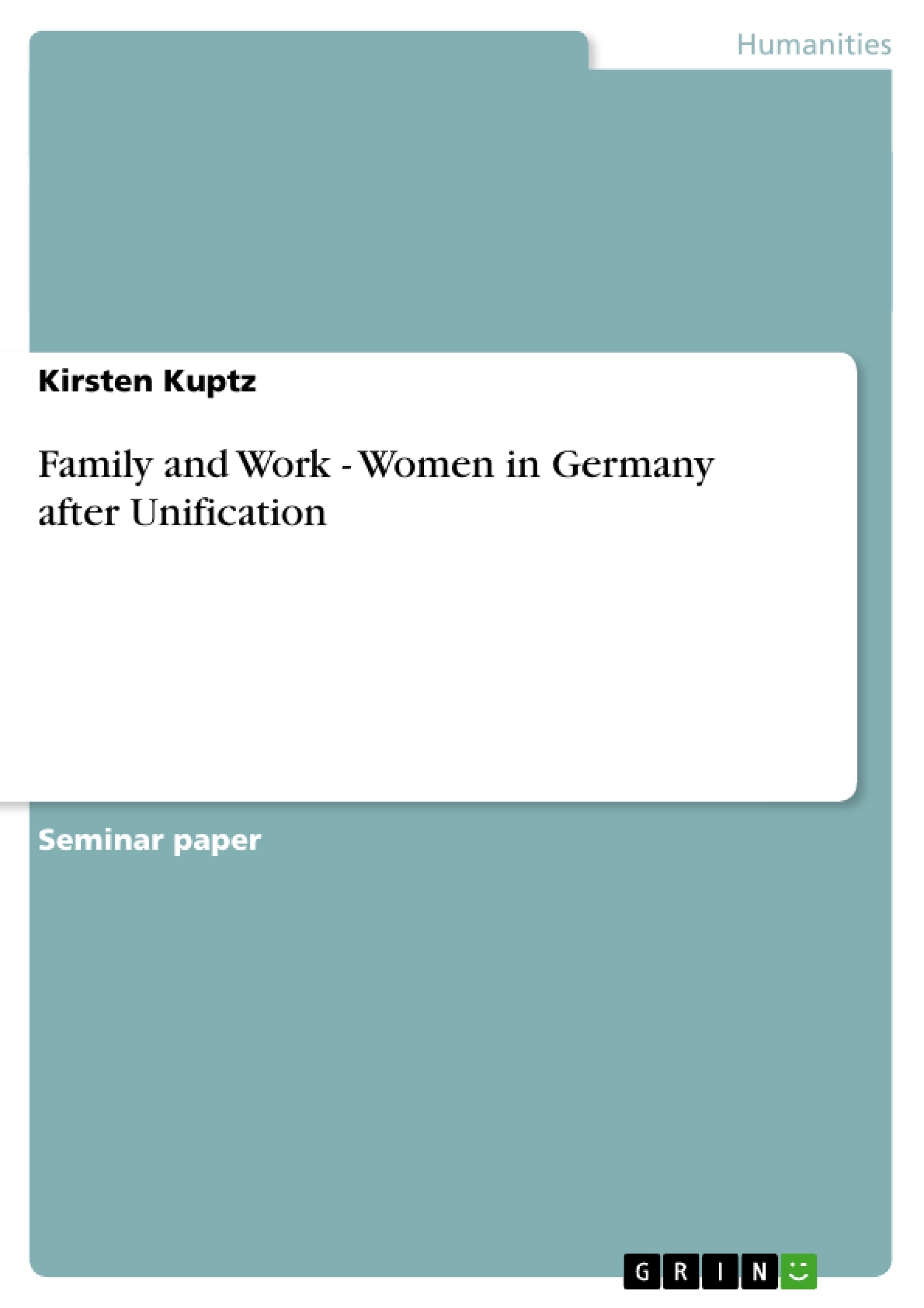When in 1990 the two German states unified, the government of the FRG and the populations
of both states faced a great challenge. During forty years, the democratic West Germany and
the socialist East Germany had developed in opposite directions. The different legal,
ideological, and economic systems were reflected in policies pursued by the governments.
While individual lives in the East were substantially predetermined by the state, people in the
West had greater personal autonomy in shaping their lives.This was highly visible in respect
to the relationship between two essential life spheres: family and work. Despite the generally
higher level of modernization, in the FRG the traditional family form of male breadwinner
and female homemaker was prevailing and endorsed by the government. In the GDR, in
contrast, policies focused on gender equality and the compatibility of employment and family
for women.
The process of unification, thus, meant a long and – initially underestimated – process
of adaptation and accommodation. Speculations that women would turn out to be the losers of
these developments soon proved right. They had to struggle in various domains: since the
breakdown of Eastern industry, unemployment was a permanent threat; previously universal
childcare centers and crèches closed in huge numbers; traditional gender roles and a
completely different value system predominated in the new society. For East German women,
therefore, new opportunities such as freedom of speech and to travel were accompanied by
unknown feelings of uncertainty, insecurity, and fear of their own and their children’s future.
This paper seeks to provide insight in the effects of German unification on women, in
particular in the former GDR. The first section focuses on the circumstances, especially in
terms of employment and family, under which women lived in the two German states. The
major part of the paper discusses women’s lives after unification. A closer look is taken at
changes in the spheres of work, fertility, marriage, housework, and at last women’s attitudes
toward aspects of their ‘new lives’.
Inhaltsverzeichnis (Table of Contents)
- Introduction
- Women in the Two German States Before Unification
- West Germany: Equality – The Unmet Promise
- East Germany: Equality by Decree
- Women in Germany After Unification
- Work
- Fertility
- Marriage
- Housework
- Attitudes
- Conclusion
Zielsetzung und Themenschwerpunkte (Objectives and Key Themes)
This paper examines the impact of German unification on women, particularly those residing in the former GDR. It focuses on the contrasting circumstances women faced in East and West Germany prior to unification, particularly in terms of employment and family structures. The core of the paper explores the effects of unification on women's lives in the domains of work, fertility, marriage, housework, and attitudes towards their new realities.
- The contrasting social and economic systems of East and West Germany prior to unification and their impact on women's roles.
- The challenges faced by East German women following unification, including economic hardship, changes in childcare access, and the reemergence of traditional gender roles.
- The evolution of women's employment patterns in East and West Germany, highlighting the differences in access to childcare and the impact of traditional gender roles.
- The impact of unification on women's fertility rates, marriage patterns, and household responsibilities.
- The shifts in attitudes and perspectives among women in the former GDR in relation to their new lives.
Zusammenfassung der Kapitel (Chapter Summaries)
The introduction outlines the context of German unification and the significant differences between East and West Germany in terms of social and economic systems. It highlights how these differences impacted the roles of women in both societies. The paper then delves into the specific experiences of women in the two German states before unification, examining the contrasting policies and social norms that shaped their lives.
The chapter on West Germany explores the concept of "equality" as a constitutional promise that was implemented slowly due to the tension between gender equality and the principle of freedom of contract. It analyzes the traditional family model favored by the West German welfare state and the limited support provided for working mothers. This chapter also investigates the "three-phase model" of women's employment patterns, characterized by an exit from the labor force to raise children followed by a part-time return.
The chapter on East Germany focuses on the socialist policies aimed at promoting gender equality and the compatibility of employment and family for women. It describes the existence of universal childcare and the prevalence of full-time employment among women. The chapter concludes by analyzing the consequences of these policies on women's lives in the East.
The subsequent chapters examine the impact of unification on women's lives in the former GDR. The chapter on "Work" explores the economic challenges faced by East German women, including rising unemployment and the closure of childcare centers. The "Fertility" chapter examines the changes in birth rates, while "Marriage" looks at the evolving patterns of marriage and family formation. The "Housework" chapter discusses the division of labor within households, while the final chapter, "Attitudes", investigates the shifts in women's perspectives and experiences in the new unified Germany.
Schlüsselwörter (Keywords)
This study focuses on the impact of German unification on women, particularly those residing in the former GDR. Key themes include gender equality, women's employment, childcare access, traditional family models, fertility rates, and the adaptation of East German women to the new social and economic environment after unification. The paper examines the interplay of social policies, economic factors, and individual experiences in shaping the lives of women in a rapidly changing society.
- Quote paper
- Kirsten Kuptz (Author), 2004, Family and Work - Women in Germany after Unification, Munich, GRIN Verlag, https://www.grin.com/document/25108



